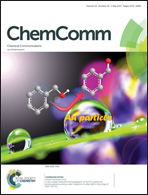Bioinspired carbide-derived carbons with hierarchical pore structure for the adsorptive removal of mercury from aqueous solution†
Abstract
Biosilica of the diatom species Thalassiosira pseudonana is used as hard template for the synthesis of silicon carbide-derived carbons. The typical species-specific macroporous structure is retained during the nanocasting-chlorine treatment process and the resulting materials exhibit very high specific surface areas up to 2300 m2 g−1. Bioinspired carbons show very high capacities in mercury adsorption from aqueous solution compared to reference materials.



 Please wait while we load your content...
Please wait while we load your content...